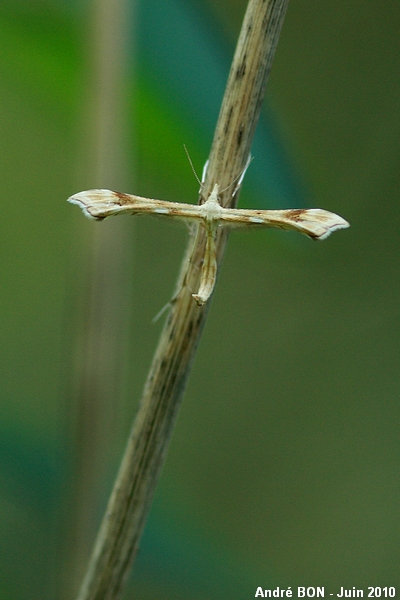
| Gillmeria ochrodactyla (Denis & Schiffermüller, 1775) |

|
|
Scientific name: Gillmeria ochrodactyla (Denis & Schiffermüller, 1775) Common name: Other names: Other scientific name: Platyptilia ochrodactyla. French name: Order: Lepidoptera Suborder: Microlepidoptera Family: Pterophoridae Subfamily: Pteriphorinae Wingspan: 23-27 mm. Biotope: Waste lands and clearings where the host plant grows. Geographic area: Europe, Iran Flight time: June to early September. Number of generations : 1 Caterpillar: Whitish brown with a black head. It grows on the host plant flowers from August to October and then go down among the roots to over winter. It grows again in April by mining the stem of a new shoot. Host plant: Common Tansy (Tanacetum vulgare). |
Like all other Plume moths Gillmeria ochrodactyla has its fore wings split in two parts and its hind wings split in three parts. The legs are very long and thin. There are many similar species (142 Pterophoridae species in France) and it is quite difficult to be sure of the species. Let's mention Gillmeria pallidactyla which has a single continuous brown mark on the hind legs. Gillmeria ochrodactyla shows three brown marks separated by white areas. Platyptilia calodactyla has darker marks, in particular the dark brown triangles on the costal edge of the fore wings. The most similar species is Platyptilia gonodactyla. The main difference that I have noticed, after having browsed several galleries, is that the costal mark is clearly triangle-shaped on Platyptilia gonodactyla while it appears more as a blurred patch on Gillmeria ochrodactyla. However you need to take this criteria with reserve as there may be important variation among moths of the same species. Furthermore, Gillmeria ochrodactyla shows a conical-shaped extension of the head at the front of the antennae. This extension is not so important on Platyptilia gonodactyla. |
| [To know more about the Gillmeria ochrodactyla] [Top] |

|
I have observed this Gillmeria ochrodactyla in a clearing where Common Tansy grows. I have told this species apart with the information got on www.ukmoths.org.uk. Though they are a little blurred, the markings on the hind legs are quite visible. |